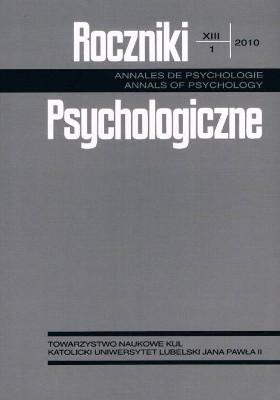Aurea mediocritas, czyli o tym, czy jakość może przejść w ilość
References
Alexander, Ch. (2002). The nature of order. An essay on the art of building and the nature of the universe. T. 1: The phenomenon of life. Berkeley, CA: Center for Environmental Structure.
Alexander, Ch., Silverstein, M., Angel, S., Ishikawa, S., Abrams, D. (1977/2008). Język wzorców. Sopot: Gdańskie Wydawnictwo Psychologiczne.
Buttimer, A., Seamon, D. (1980). The human experience of space and place. New York: Croom Helm.
Gieryn, T. F. (2000). A space for place in sociology. Annual Review of Sociology, 26, 463-496.
Giuliani, M. V. (2003). Theory of attachment and place attachment. W: M. Bonnes, T. Lee, M. Bonaiuto (red.), Psychological theories for environmental issues (s. 137-170). Hants: Ashgate.
Hinton, P. R. (1993). The psychology of interpersonal perception. London-New York: Routledge.
Lewicka, M., Bańka, A. (2008). Psychologia środowiskowa. W: D. Doliński, J. Strelau (red.), Psychologia. Podręcznik akademicki (s. 497-544). Gdańsk: Gdańskie Wydawnictwo Psychologiczne.
Low, S. M. (1992). Symbolic ties that bind. Place attachment in the plaza. W: I. Altman, S. M. Low (red.), Place attachment (s. 165-185). New York-London: Plenum Press.
McGuire, W. J. (1997). Creative hypotheses generating in psychology: Some useful heuristics. Annual Review of Psychology, 48, 1-30.
Norberg-Schultz, C. (1980). Genius loci: Towards a phenomenology of architecture. London: Academy Editions.
Patterson, M. E., Williams, D. R. (2005). Maintaining research traditions on place: Diversity of thought and scientific progress. Journal of Environmental Psychology, 25, 361-380.
Relph, E. (1976). Place and placelessness. London: Pion Limited.
Russell, J. A., Snodgrass, J. (1987). Emotion and the environment. W: D. Stokols, I. Altman (red.), Handbook of environmental psychology (t. 1, s. 245-280). New York: John Wiley.
Sagan, I. (2000). Metodologiczne dylematy współczesnej geografii społeczno-ekonomicznej. Studia Regionalne i Lokalne, 2, 5-20.
Salingaros, N. (2005). Principles of urban structure. Delft University of Technology: Techne Press.
Salingaros, N. A. (2006). A theory of architecture. Nikos A. Salingaros & Umbau-Verlag.
Scheerer, K. R., Schorr, A., Johnstone, T. (red.) (2001). Appraisal processes in emotion: Theory, methods, research. Oxford: Oxford University Press.
Seamon, D. (2000). A way of seeing people and place: Phenomenology in environment-behavior research. W: S. Wapner, J. Demick, T. Yamamoto, H. Minami (red.), Theoretical perspectives in environment-behavior research: Underlying assumptions, research problems, and methodologies (s. 157-178). New York: Kluver Academic/Plenum Publishers.
Seamon, D. (2002). A world more robust and kind: The first volume in Christopher Alexander’s Nature of Order. Environmental and Architectural Phenomenology Newsletter, 13, 4-8.
Stedman, R. C. (2003). Sense of place and forest science: Toward a program of quantitative research. Forest Science, 49, 822-829.
Tuan, Y.-F. (1975). Place: An experiential perspective. The Geographical Review, 65, 151-165.
Tuan, Y.-F. (1977). Space and place: The perspective of experience. Minnesota: The University of Minnesota Press.
Twigger-Ross, C. L., Uzzell, D. (1996). Place and identity processes. Journal of Environmental Psychology, 16, 205-220.
Varela, F. J., Thomson, E., Rosch, E. (1991). The embodied mind: Cognitive science and human experience. Cambridge, MA: MIT.
Wojciszke, B., Baryła, W. (2006). Perspektywa sprawcy i biorcy w spostrzeganiu siebie i innych. Psychologia Społeczna, 1, 9-32.
Alexander, Ch., Silverstein, M., Angel, S., Ishikawa, S., Abrams, D. (1977/2008). Język wzorców. Sopot: Gdańskie Wydawnictwo Psychologiczne.
Buttimer, A., Seamon, D. (1980). The human experience of space and place. New York: Croom Helm.
Gieryn, T. F. (2000). A space for place in sociology. Annual Review of Sociology, 26, 463-496.
Giuliani, M. V. (2003). Theory of attachment and place attachment. W: M. Bonnes, T. Lee, M. Bonaiuto (red.), Psychological theories for environmental issues (s. 137-170). Hants: Ashgate.
Hinton, P. R. (1993). The psychology of interpersonal perception. London-New York: Routledge.
Lewicka, M., Bańka, A. (2008). Psychologia środowiskowa. W: D. Doliński, J. Strelau (red.), Psychologia. Podręcznik akademicki (s. 497-544). Gdańsk: Gdańskie Wydawnictwo Psychologiczne.
Low, S. M. (1992). Symbolic ties that bind. Place attachment in the plaza. W: I. Altman, S. M. Low (red.), Place attachment (s. 165-185). New York-London: Plenum Press.
McGuire, W. J. (1997). Creative hypotheses generating in psychology: Some useful heuristics. Annual Review of Psychology, 48, 1-30.
Norberg-Schultz, C. (1980). Genius loci: Towards a phenomenology of architecture. London: Academy Editions.
Patterson, M. E., Williams, D. R. (2005). Maintaining research traditions on place: Diversity of thought and scientific progress. Journal of Environmental Psychology, 25, 361-380.
Relph, E. (1976). Place and placelessness. London: Pion Limited.
Russell, J. A., Snodgrass, J. (1987). Emotion and the environment. W: D. Stokols, I. Altman (red.), Handbook of environmental psychology (t. 1, s. 245-280). New York: John Wiley.
Sagan, I. (2000). Metodologiczne dylematy współczesnej geografii społeczno-ekonomicznej. Studia Regionalne i Lokalne, 2, 5-20.
Salingaros, N. (2005). Principles of urban structure. Delft University of Technology: Techne Press.
Salingaros, N. A. (2006). A theory of architecture. Nikos A. Salingaros & Umbau-Verlag.
Scheerer, K. R., Schorr, A., Johnstone, T. (red.) (2001). Appraisal processes in emotion: Theory, methods, research. Oxford: Oxford University Press.
Seamon, D. (2000). A way of seeing people and place: Phenomenology in environment-behavior research. W: S. Wapner, J. Demick, T. Yamamoto, H. Minami (red.), Theoretical perspectives in environment-behavior research: Underlying assumptions, research problems, and methodologies (s. 157-178). New York: Kluver Academic/Plenum Publishers.
Seamon, D. (2002). A world more robust and kind: The first volume in Christopher Alexander’s Nature of Order. Environmental and Architectural Phenomenology Newsletter, 13, 4-8.
Stedman, R. C. (2003). Sense of place and forest science: Toward a program of quantitative research. Forest Science, 49, 822-829.
Tuan, Y.-F. (1975). Place: An experiential perspective. The Geographical Review, 65, 151-165.
Tuan, Y.-F. (1977). Space and place: The perspective of experience. Minnesota: The University of Minnesota Press.
Twigger-Ross, C. L., Uzzell, D. (1996). Place and identity processes. Journal of Environmental Psychology, 16, 205-220.
Varela, F. J., Thomson, E., Rosch, E. (1991). The embodied mind: Cognitive science and human experience. Cambridge, MA: MIT.
Wojciszke, B., Baryła, W. (2006). Perspektywa sprawcy i biorcy w spostrzeganiu siebie i innych. Psychologia Społeczna, 1, 9-32.
Published
2019-03-29
Issue
Section
Discussion
Copyright (c) 2010 Roczniki Psychologiczne

This work is licensed under a Creative Commons Attribution-NonCommercial-NoDerivatives 4.0 International License.


